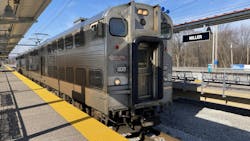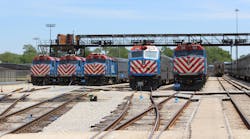Last week, the House of Representatives’ Transportation and Infrastructure Committee’s Subcommittee on Railroads, Pipelines, and Hazardous Materials held a hearing that addressed some of the most pressing issues facing commuter railroads in the U.S. Mike Noland, president of the Northern Indiana Commuter Transportation District and chairman of the Commuter Rail Coalition, drew the subcommittee’s attention to the current illogical state of the excess liability insurance market and its impact on commuter railroads.
The U.S.'s commuter railroads are expected by third-party partners, like host railroads and positive train control software and radio system suppliers, to maintain excess liability insurance coverage up to the federal cap. At $323 million per year, that insurance is a steep requirement that is impossible to fulfill by purchasing from U.S. insurers; commuter railroads are forced to find most of the excess liability coverage in foreign markets.
To make matters more difficult, the federal cap is adjusted every five years in line with the consumer price index. When the new federal excess liability cap number is published by the Office of the Secretary of the Department of Transportation in early 2026, commuter railroads will have just 30 days to acquire the additional coverage they need. If they are unable to secure adequate coverage, they would likely be forced to suspend operations.
Last week’s subcommittee hearing provided a concise explanation of the problem and how it might be resolved. In addition, the hearing offered an opportunity to discuss longer term solutions to the instability witnessed in the insurance markets that threaten future operations. The subcommittee chairman’s response on the insurance issue was promising.
“It has my attention and hopefully the members of this subcommittee and we’re going to continue to look into that because you should be able to buy that insurance here someplace in the United States,” said U.S. Rep. Troy Nehls (R-TX-22), chairman of the Subcommittee on Railroads, Pipelines, and Hazardous Materials.
Last week’s hearing was an important step but it’s critical that we address the problem quickly by moving from words to actions. The U.S.'s 32 commuter railroads and the millions of Americans they serve on a daily basis need Congress to pass legislation extending the implementation window for excess liability insurance from 30 days to 365 days. This additional time will give the commuter railroads the opportunity to approach the foreign excess liability markets in an orderly fashion and not in a panic-buying 30-day window.
As we look beyond the 2026 adjustment to the federal insurance cap, we must also implement structural changes that will protect commuter rail systems and their passengers from an all-out collapse in the foreign excess liability insurance market.
No time to waste on implementation fix
The next adjustment to the federal insurance cap is just 19 months away, a remarkably small window to reach a legislative solution.
Commuter railroads in the United States purchase excess liability insurance on an annual basis. When these railroads enter the market to secure coverage up to the federal cap, they see each year that it is impossible to purchase the coverage they need from U.S.-based insurers. U.S. insurers who had offered such coverage previously exited this market years ago. And despite the fact that the commuter rail industry as a whole is viewed as a low risk, with no major insurable losses since the implementation of positive train control, U.S. insurers have elected to place their bets elsewhere and provide coverage in other industries.
U.S. commuter railroads purchase insurance from multiple providers, most of them overseas insurers located in the United Kingdom and Bermuda. Noland referenced this in his subcommittee testimony. When Chicago’s Metra commuter rail line last renewed its excess liability insurance, its total coverage was divided into 35 layers with 22 of those slots filled by London insurers, six by carriers from Bermuda and one by another European insurer. Not a single piece of Metra’s coverage was provided by a U.S.-based insurance company.
Every year that goes by without addressing the problems in this insurance market forces our commuter railroads to take tens of millions of dollars of public money — paid for by U.S. taxpayers — and spend it abroad.
Overall instability in the worldwide insurance market threatens to make matters much, much worse. A hardened market for property insurance is making it expensive, if not impossible, for homeowners in some states to buy the coverage they need. It’s entirely possible that this same situation could take place for commuter railroads, and with the current 30-day implementation requirement, that could force some railroads to have to stop running immediately.
Looking to long-term solutions
What would it look like to apply a long-term fix to commuter railroads’ insurance challenges?
Noland suggested the option of an industry insurance pool in his testimony.
“We are clear-eyed as to the hurdles of establishing an industry insurance pool,” said Noland. “A multi-state agreement to share liability is no small undertaking, especially when navigating varying state liability caps and tort immunity protections. We are actively discussing these options and ask Congress to assist us by supporting studies and, potentially, federally-supported loans needed for capitalizing a commuter rail industry liability pool.”
Another short-term or perhaps long-term solution could see the federal government offer a backstop if the excess liability insurance market fails. There is precedent for this solution: In 2002, Congress enacted the Terrorism Risk Insurance Act to provide a backstop for claims related to acts of terrorism when the market failed following 9/11. Deploying a similar backstop in the event of insurance market failure would guarantee stability and continued operations for commuter railroads across the country while a longer-term solution is completed.
Last week’s hearing on the issues facing commuter railroads was an important step and Chairman Nehls’ comments give our industry reason to hope that the insurance issue will eventually be resolved. But we can’t afford to take our time. Extending the 30-day implementation window to 365 days will ensure commuter railroads in the U.S. can have the time necessary to secure the additional coverage and allow them to operate with confidence. Stabilizing the U.S. insurance market will allow taxpayer money to stay within the borders of the United States. We need both solutions for a prosperous future for commuter rail.






